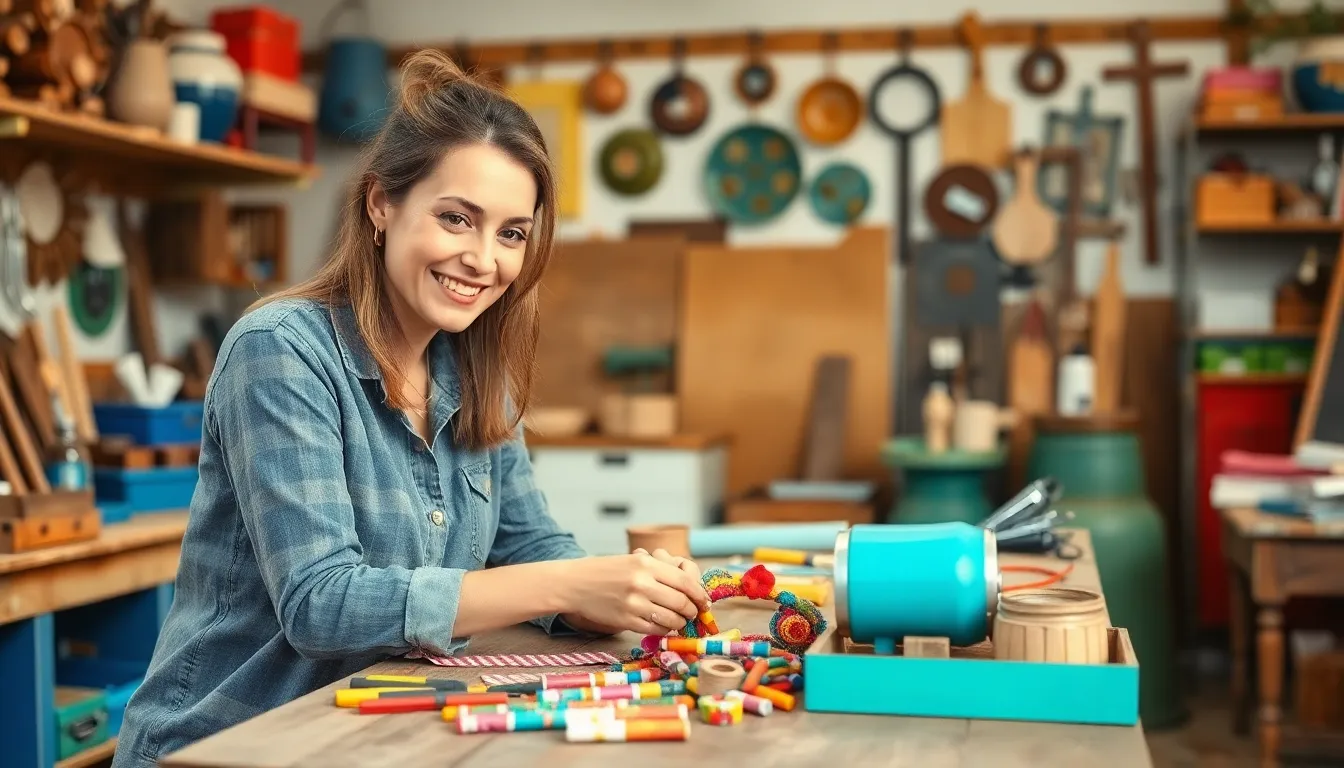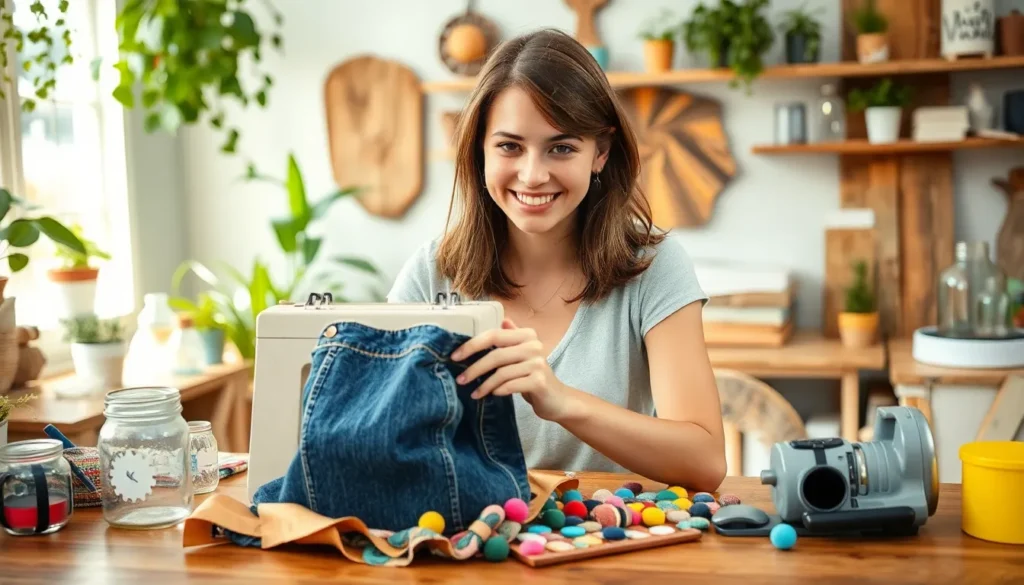In a world overflowing with waste, upcycling crafts are the superheroes we didn’t know we needed. Imagine transforming an old pair of jeans into a chic tote bag or turning glass jars into whimsical lanterns. Upcycling not only saves the planet but also sparks creativity and adds a personal touch to home décor.
Table of Contents
ToggleWhat Are Upcycled Craft Ideas?
Upcycled craft ideas involve repurposing materials that may otherwise end up in landfills. Individuals transform everyday items into new, creative projects through this sustainable practice. These crafts not only reduce waste but also encourage creativity and resourcefulness.
Common examples include turning old jeans into stylish tote bags, creating home décor from glass jars, and crafting furniture from reclaimed wood. Each project showcases the potential of items that people often overlook. Upcycling allows crafters to save money while producing unique items tailored to their preferences.
Many people engage in upcycled crafts as a form of personal expression. They can customize these creations to match their style or improve functionality. Think about how someone might create a lantern from a mason jar to add charm to their living space.
The process often leads to discovering hidden talents. Crafters develop skills in sewing, woodworking, and painting through various projects. As they experiment, they often find joy in the journey of making something new out of the old.
Upcycled crafts also promote environmental awareness. By supporting the use of discarded materials, individuals contribute to reducing the demand for new products. This shift not only helps the planet but also inspires a community spirit where people share ideas and inspire each other to create.
Crafting with upcycled materials enhances sustainability while providing a rewarding creative outlet. Overall, this approach aligns perfectly with the growing desire to live a more eco-friendly lifestyle.
Benefits of Upcycling


Upcycling offers numerous advantages beyond just creativity.
Environmental Impact
Upcycling significantly reduces waste. By transforming discarded items, individuals prevent materials from reaching landfills. Crafting from repurposed goods conserves resources, minimizing the demand for new products. The process lowers carbon footprints associated with manufacturing. Many projects, like creating furniture from pallets, contribute to the circular economy by extending the lifespan of materials. Communities benefit as local ecosystems thrive when waste decreases. People embrace sustainability through upcycling, fostering a collective commitment to environmental stewardship.
Economic Advantages
Upcycling presents several financial benefits. Transforming old items into new creations saves money on purchasing new products. Take, for instance, using glass jars to create storage solutions instead of buying new containers. Individuals often discover that they can generate income by selling upcycled crafts. Marketplaces provide platforms for selling items, creating potential revenue streams. Saving on material costs enables crafters to invest in other projects or share resources with fellow enthusiasts. Overall, upcycled crafts offer a practical approach to budgeting while promoting unique craftsmanship.
Creative Upcycled Craft Ideas
Upcycling fosters creativity by transforming discarded materials into functional and stylish items. Here are some innovative projects to consider:
Home Decor Projects
Transforming glass jars into decorative lanterns enhances any space’s ambiance. Painted or wrapped with twine, these jars can hold candles or flowers. Reclaimed wood offers endless possibilities, serving as unique shelves or rustic wall art. Old picture frames can be repurposed into mirrors or chalkboards, adding a personalized touch to rooms. These home decor projects not only beautify spaces but also reduce waste effectively.
Fashion and Accessories
Old jeans can quickly become fashionable tote bags with a few simple sewing techniques. A t-shirt can transition into a trendy, reusable shopping bag through straightforward cutting and stitching methods. Using buttons from discarded shirts, crafters create unique accessories like brooches or keychains. Scarves made from repurposed fabric can double as hair accessories or decorative additions to simple outfits. Each project allows personal style to shine while promoting sustainability.
Gifts and Keepsakes
Crafters can turn old books into custom journals, gifting them a second life. Additionally, glass bottles can evolve into beautiful vases, making memorable presents. Handmade soaps packaged in repurposed containers provide thoughtful, eco-friendly gifts. Personalized photo albums can be crafted using old cardboard, showcasing cherished memories uniquely. Upcycling for gifts not only shares creativity but also promotes environmental consciousness.
Tips for Successful Upcycling
Successful upcycling starts with thoughtful planning and execution. Crafting unique items from waste materials requires attention to detail and creativity.
Choosing the Right Materials
Selecting suitable upcycling materials enhances project outcomes. Consider durability and texture when picking items. For instance, sturdy old jeans make excellent totes, while glass jars can serve multiple decorative purposes. Assess the aesthetic appeal; colors and patterns can significantly impact the final look. Repurposing items that hold personal value also adds sentimental significance to projects. Look for materials that are easily accessible, whether found at home or sourced from thrift stores. Prioritizing these factors leads to more satisfying and successful outcomes.
Essential Tools and Supplies
Having the right tools makes transforming materials easier. Basic supplies such as scissors, glue, and paint significantly streamline the process. A sewing machine proves invaluable for fabric-based projects, while a drill and saw assist with wooden crafts. Incorporate additional items like sandpaper for smoothing surfaces and brushes for painting details. Organizing a dedicated workspace fosters creativity and keeps tools readily accessible. Using high-quality supplies increases work efficiency and enhances the final product’s appearance. Prioritize gathering these essential tools to ensure smooth crafting sessions.




